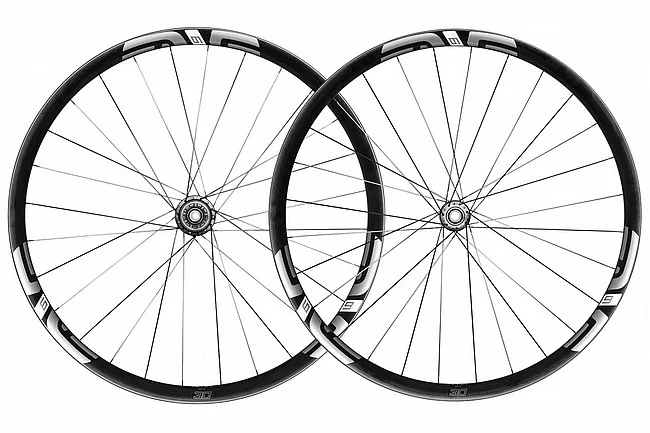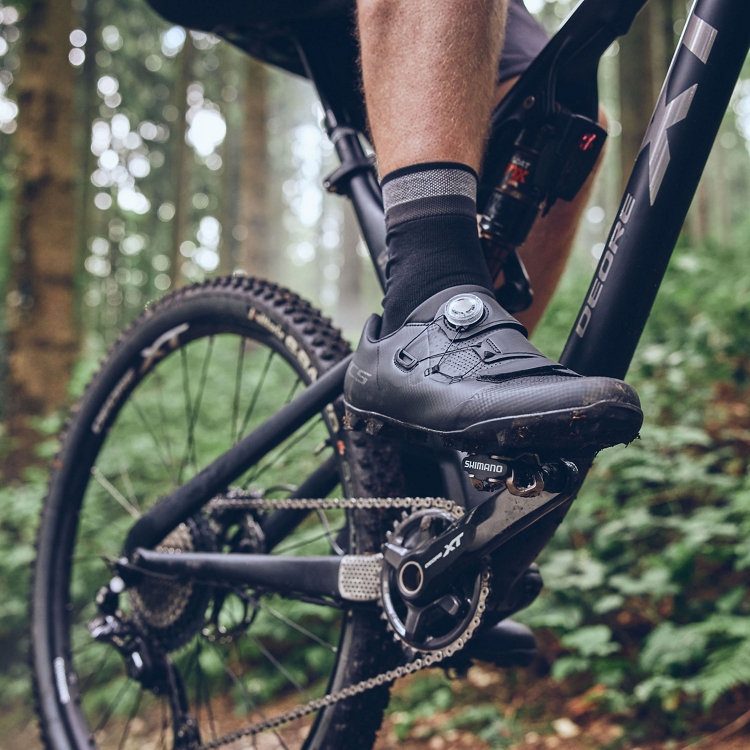Carbon vs Aluminum Mountain Bike Wheels

When it comes to choosing Carbon vs Aluminum Mountain Bike Wheels, my decision has often been influenced by the specific bike I’m using and the kind of riding I plan to do with it. Here are some insights that I hope you’ll find useful.
General Characteristics:
- Weight: Carbon wheels are generally lighter, benefiting climbing and acceleration. Aluminum wheels tend to be heavier but are catching up with modern techniques.
- Stiffness: Carbon can offer greater stiffness, improving steering precision, while aluminum tends to be less stiff, providing a more compliant ride.
- Durability: Carbon can crack under severe impact but is durable with typical use. Aluminum can dent but is less likely to crack and can often be repaired.
- Price: Carbon wheels are generally more expensive, while aluminum offers a better price-to-performance ratio.
- Maintenance & Longevity: Carbon requires inspection after hard impacts, while aluminum shows damage more overtly and can often be repaired.
- Feel: Carbon’s stiffness might lead to a harsher ride on rough terrains, whereas aluminum offers a more forgiving feel.
- Aesthetics: Carbon has a “premium” appearance, while aluminum has a traditional look.
- Braking Surface: For rim-brake wheels, carbon may offer less consistent performance, especially in wet conditions, and requires special brake pads. Aluminum provides consistent and reliable braking.
Discipline-Specific Applications:
- Cross Country (XC):
- Carbon: Preferred for its lightweight and stiffness, providing a competitive edge.
- Aluminum: A choice for budget-conscious riders, with modern versions still offering good performance.
- Trail:
- Carbon: Offers a balance of weight and strength, beneficial for technical terrains.
- Aluminum: Ideal for longer rides on rough terrains, providing comfort and cost-effectiveness.
- Enduro:
- Carbon: Chosen for specific designs that reinforce strength, though risks exist with aggressive riding.
- Aluminum: Popular due to its resilience against hard impacts and potential repairability.
- Downhill (DH):
- Carbon: Used by some professionals for its stiffness, but must be DH-specific to withstand the rigors.
- Aluminum: The dominant choice due to the intense forces and impacts involved, prized for its durability.
Final Thoughts:
The choice between carbon and aluminum depends on the rider’s preferences, budget, and riding style. While carbon offers performance benefits in terms of weight and stiffness, aluminum is often chosen for its durability and value, especially in more aggressive riding disciplines. Riders should consider their specific needs and potentially test-ride both types of wheels to make the best decision.
Click here to see the Best Mountain Bike Wheels reviewed and rated.
Have fun!!! John
List of the Top Mountain Bike Wheel Manufacturers
FAQ’s
Are carbon wheels worth it for mountain biking?
Whether carbon wheels are “worth it” for mountain biking largely depends on the rider’s priorities, budget, and the type of riding they do. Here are some factors to consider when weighing the value of carbon wheels for mountain biking:
- Performance Advantages:
- Weight: Carbon wheels are generally lighter than their aluminum counterparts. A lighter wheel can improve acceleration, climbing, and overall bike handling.
- Stiffness: Carbon wheels can offer a stiffer ride, which many riders feel provides better responsiveness and precision, especially during aggressive cornering.
- Durability Concerns:
- While modern carbon wheels are robust and can handle a lot of abuse, they can crack under significant impact. Aluminum, on the other hand, might dent but is less likely to suffer catastrophic failure.
- If you frequently ride in rocky terrains or engage in aggressive styles like downhill or enduro, you’ll need to weigh the benefits of performance against the potential risks of damaging the wheels.
- Ride Feel:
- Some riders prefer the feel of carbon wheels, citing improved trail feedback and precision. Others find them too stiff and prefer the more compliant nature of aluminum.
- Cost:
- Carbon wheels are generally more expensive than aluminum wheels. You’ll need to consider if the performance benefits justify the additional cost, especially given the potential for damage in rough terrains.
- Resale Value:
- Bikes or wheelsets with carbon wheels often have a higher resale value compared to those with aluminum wheels.
- Aesthetics & Prestige:
- Some riders appreciate the premium look of carbon, and there’s no denying that there’s a certain prestige associated with carbon components.
- Discipline-Specific Needs:
- For cross-country (XC) and some trail riders, where weight and acceleration are paramount, carbon might offer a more noticeable benefit.
- For downhill (DH) and enduro riders, where the likelihood of wheel impact is higher, the durability of aluminum might be more appealing.
Conclusion: Carbon wheels offer tangible performance benefits, but they come at a cost – both in terms of actual price and potential durability concerns in certain riding conditions. For competitive riders or those for whom budget is less of a concern, the advantages of carbon might be compelling. However, many mountain bikers find that modern aluminum wheels offer excellent performance at a fraction of the cost. As with many things in mountain biking, personal preference plays a significant role, so it’s beneficial to test ride different wheelsets if possible before making a decision.
Do carbon wheels ride better than aluminum?
“Better” can be subjective, but there are distinct differences in how carbon and aluminum wheels ride. Here are some factors to consider when comparing the ride characteristics of carbon versus aluminum mountain bike wheels:
- Stiffness:
- Carbon wheels tend to be stiffer than aluminum. This increased stiffness can translate to more precise handling and quicker response to rider input. For some, this gives a feeling of better connection to the trail and improved control, especially during aggressive cornering.
- However, there’s a flip side: some riders feel that overly stiff wheels can transmit more trail chatter, leading to a harsher ride on rough terrains.
- Weight:
- Carbon wheels are generally lighter than aluminum wheels, especially when comparing top-end models. A lighter wheelset can make the bike feel more agile, easier to accelerate, and quicker to change directions.
- Compliance and Vibration Damping:
- Aluminum naturally has some level of elasticity, which can provide a bit of “give” or compliance when riding over rough terrain. This can result in a smoother ride feel on certain trails.
- Carbon can be engineered to have specific flex patterns, but in general, it tends to dampen high-frequency vibrations better than aluminum. This can result in a smoother ride on trails with small, high-frequency bumps or chatter.
- Durability and Impact Response:
- While carbon wheels can handle a lot, a hard impact (like smashing into a rock) can result in a crack. Once carbon is cracked, its structural integrity is compromised.
- Aluminum might dent upon impact, but a dented aluminum rim can sometimes still be ridden (albeit not perfectly). The more “forgiving” nature of aluminum might be perceived as “better” by some riders who ride in rocky terrains or are more prone to mishaps.
- Aesthetics and Perception:
- Some riders feel that carbon wheels look and sound better, giving a more premium ride experience. The psychological aspect of having a high-end component can make some riders feel that their overall ride is better, even if the tangible benefits are minimal.
Conclusion: Whether carbon wheels ride “better” than aluminum wheels depends on personal preferences and the specific demands of the rider. Some mountain bikers swear by the responsiveness and feel of carbon, while others prefer the more compliant and forgiving nature of aluminum. Testing both materials in real-world conditions, ideally on familiar trails, is the best way to determine which ride feel suits an individual’s preferences and riding style.
What are the disadvantages of carbon wheels?
Carbon wheels, despite their many advantages, do come with certain drawbacks. Here are the main disadvantages of carbon wheels:
- Cost:
- One of the most apparent disadvantages of carbon wheels is their price. They are generally more expensive than aluminum wheels, sometimes significantly so. This higher cost can be prohibitive for many riders.
- Durability and Impact Resistance:
- While carbon wheels are strong and can handle considerable stress, they can crack or fracture upon hard impact, like smashing into a rock or experiencing a severe crash. Once carbon is compromised, its structural integrity is greatly reduced.
- Aluminum wheels, in contrast, might dent under similar circumstances but can sometimes still be ridden or repaired.
- Repairability:
- Repairing a cracked or damaged carbon rim is more challenging than fixing a dented aluminum rim. In many cases, a damaged carbon rim might be deemed unrepairable and will need replacement.
- Ride Feel:
- The increased stiffness of carbon can sometimes result in a harsher ride feel, especially on rough terrains. Some riders might find this stiffness to be less forgiving than the natural compliance of aluminum.
- Braking Performance (for rim-brake models):
- Carbon rims can offer inconsistent braking performance, especially in wet conditions. They also require specific carbon-friendly brake pads, which can wear out faster than those used for aluminum rims.
- Heat Management (for rim-brake models):
- Prolonged braking, such as on long descents, can cause heat build-up on carbon rims, which can affect the integrity of the rim and the performance of tubular or tubeless glues/sealants. Modern carbon rims have improved in this regard, but it’s still a consideration for riders in mountainous areas.
- Aesthetics and Wear:
- Over time, brake tracks on carbon rims (for those using rim brakes) can show wear, potentially impacting the wheel’s aesthetics. Additionally, scratched or scuffed carbon doesn’t “heal” or polish out as metal might.
- UV Exposure:
- Prolonged exposure to UV rays can degrade the resin in carbon fiber over time. While this process is slow and most modern coatings protect against UV damage, it’s still a consideration for those storing bikes in direct sunlight.
- Compatibility Issues:
- Some carbon rims have specific requirements for tire widths, tire bead types, or spoke tension, which can limit compatibility with certain tire or hub models.
Conclusion: While carbon wheels offer numerous performance benefits like weight savings and increased stiffness, these advantages come with trade-offs. Riders considering carbon wheels should weigh these disadvantages against the benefits, considering their specific riding style, budget, and priorities.





